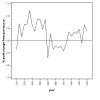Infant feeding and the media: the relationship between Parents' Magazine content and breastfeeding, 1972-2000
- PMID: 16722542
- PMCID: PMC1489921
- DOI: 10.1186/1746-4358-1-10
Infant feeding and the media: the relationship between Parents' Magazine content and breastfeeding, 1972-2000
Abstract
Mass media content likely influences the decision of women to breastfeed their newborn children. Relatively few studies have empirically assessed such a hypothesis to date, however. Most work has tended to focus either on specific interventions or on broad general commentary about the role of media. In this study, we examined infant feeding advertisements in 87 issues of Parents' Magazine, a popular parenting magazine, from the years 1971 through 1999. We then used content analysis results to predict subsequent changes in levels of breastfeeding among U.S. women. When the frequency of hand feeding advertisements increased, the percentage change in breastfeeding rates reported the next year generally tended to decrease. These results underscore the need to acknowledge the potential role of popular media content in understanding breastfeeding patterns and public health trends.
Figures




Similar articles
-
Perpetuating "scientific motherhood": infant feeding discourse in Parents magazine, 1930-2007.Women Health. 2010 May;50(3):297-311. doi: 10.1080/03630242.2010.480905. Women Health. 2010. PMID: 20512747
-
A Content Analysis of Infant and Toddler Food Advertisements in Taiwanese Popular Pregnancy and Early Parenting Magazines.J Hum Lact. 2015 Aug;31(3):458-66. doi: 10.1177/0890334415576513. Epub 2015 Mar 12. J Hum Lact. 2015. PMID: 25766374
-
Place of sanctuary: an appreciative inquiry approach to discovering how communities support breastfeeding and parenting.Int Breastfeed J. 2019 Jun 11;14:25. doi: 10.1186/s13006-019-0219-8. eCollection 2019. Int Breastfeed J. 2019. PMID: 31205480 Free PMC article.
-
Cultural paradoxes relating to sexuality and breastfeeding.J Hum Lact. 1995 Jun;11(2):111-5. doi: 10.1177/089033449501100215. J Hum Lact. 1995. PMID: 7619289
-
An Integrative Review: Understanding Parental Use of Social Media to Influence Infant and Child Health.Matern Child Health J. 2019 Oct;23(10):1360-1370. doi: 10.1007/s10995-019-02781-w. Matern Child Health J. 2019. PMID: 31222601 Review.
Cited by
-
Use of online promotion to encourage patient awareness of aspirin use to prevent heart attack and stroke.J Epidemiol Community Health. 2018 Nov;72(11):1059-1063. doi: 10.1136/jech-2018-210676. Epub 2018 Aug 6. J Epidemiol Community Health. 2018. PMID: 30082425 Free PMC article. Review.
-
Media and breastfeeding: friend or foe?Int Breastfeed J. 2008 Aug 4;3:15. doi: 10.1186/1746-4358-3-15. Int Breastfeed J. 2008. PMID: 18680582 Free PMC article.
-
Breast-milk substitutes: a new old-threat for breastfeeding policy in developing countries. A case study in a traditionally high breastfeeding country.PLoS One. 2012;7(2):e30634. doi: 10.1371/journal.pone.0030634. Epub 2012 Feb 9. PLoS One. 2012. PMID: 22347392 Free PMC article.
-
Reasons for formula feeding among rural Bangladeshi mothers: A qualitative exploration.PLoS One. 2019 Feb 26;14(2):e0211761. doi: 10.1371/journal.pone.0211761. eCollection 2019. PLoS One. 2019. PMID: 30807588 Free PMC article. Clinical Trial.
-
Multilevel modeling analysis of bottle feeding and its determinants among children 0-23 months in East Africa: evidence from recent DHS data (2015-2022).Int Breastfeed J. 2024 Apr 8;19(1):24. doi: 10.1186/s13006-024-00629-w. Int Breastfeed J. 2024. PMID: 38589943 Free PMC article.
References
-
- Hornik R, Ed . Public Health Communication: Evidence for Behavior Change. Mahwah, New Jersey: Lawrence Erlbaum Associates; 2002.
-
- Fan D. Impact of persuasive information on secular trends in health-related behaviors. In: Hornik R, editor. Public Health Communication: Evidence for Behavior Change. Mahwah, New Jersey: Lawrence Erlbaum Associates; 2002.
-
- Soumerai S, Ross-Degnan D, Kahn J. The Effects of Professional and Media Warnings About the Association Between Asprin Use in Children and Reye's Syndrome. In: Hornik R, editor. Public Health Communication: Evidence for Behavior Change. Mahwah, New Jersey: Lawrence Erlbaum Associates; 2002.
-
- Viswanath K, Finnegan J. Reflections on community health campaigns: Secular trends and the capacity to effect change. In: Hornik R, editor. Public Health Communication: Evidence for Behavior Change. Mahwah, New Jersey: Lawrence Erlbaum Associates; 2002.
-
- Southwell B, Hornik R, Fan D, Yanovitzky I, Lazili P. Can news coverage predict mammography use? A time series analysis to predict health behavior using the ideodynamic model. Presented at the annual meeting of the International Communication Association. Acapulco, Mexico; 2000.
LinkOut - more resources
Full Text Sources
Other Literature Sources

